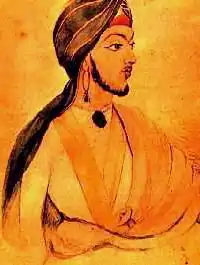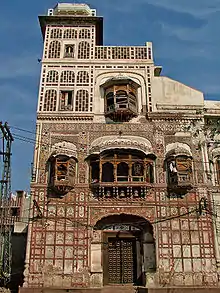Nau Nihal Singh
Maharaja Nau Nihal Singh (9 March 1821 – 6 November 1840) was a ruler of the Punjab region of the Indian subcontinent.
| Nau Nihal Singh | |
|---|---|
| Maharaja of Sikh Empire | |
 Nau Nihal Singh in court[1] | |
| 3rd Maharaja of the Sikh Empire | |
| Reign | 8 October 1839 – 6 November 1840 |
| Predecessor | Kharak Singh |
| Successor | Chand Kaur |
| Born | 11 February 1821 Lahore, Sikh Empire, (now Punjab, Pakistan) |
| Died | 6 November 1840 (aged 19) Lahore, Punjab, Sikh Empire (now Punjab, Pakistan) |
| Spouse | Maharani Nanaki Kaur Maharani Sahib Kaur |
| Issue | Shahzada Jawahar Singh
Jaswinder Singh (adopted; his adoption started at a substantial age of 3) |
| Father | Kharak Singh |
| Mother | Chand Kaur |
| Religion | Sikh |
Child adoptions
When Nau Nihal Singh was declared as Maharaja of Sikh Empire, he adopted a son of Kanhaiya Misl, a powerful remaining confederation that remained after all Misls substantially divided with Kanhaiyas undivided. He married with a Kanhaiya girl and lastly he had his biological child. His first heir was his adopted son. He, his father and his grandfather linked with Kanhaiyas.
Background
He was the son of Maharani Chand Kaur and Maharaja Kharak Singh, himself the eldest son and heir of Maharaja Ranjit Singh Sher-e-Panjab and a grandson of Maharani Datar Kaur of the Nakai Misl.
Early life
In April 1837 at the age of sixteen he was married to Bibi Sahib Kaur, a daughter of Shaheed Sardar Sham Singh Attariwala (1790–1846) of the village of Attari in Amritsar district of Punjab.
Nau Nihal was raised outside the court politics at Lahore however at the age of eighteen, and forced by his father's incapacity he returned to Lahore. He was instructed to govern in the name of his father under the direction of the vizier, Dhian Singh. When Kharak Singh became gravely ill, the court physician Johann Martin Honigberger noted that despite his father begging him to see him every day, Nau Nihal rarely visited his father.[2]
Death

Nau Nihal was popular with the royal courtiers and the general public, and was seen as a worthy successor to his father during the latter's sickness. After Kharak Singh died on 5 November 1840, Nau Nihal performed his last rites beside the Ravi River in Lahore. After the ceremony, he started returning to the palace via the Hazuri Bagh, where a massive block of stone from a gate fell upon him and two of his companions.[3] One of the companions - Udham Singh (nephew of Dhian Singh)- broke his neck and died on the spot.
According to Alexander Gardner, who was just steps behind Nau Nihal when the incident took place, the prince had sustained only minor injuries during this episode: he was well enough to walk on his own, and agreed to be taken on a stretcher only because of Gardner's insistence.[4] However, when the court physician Johann Martin Honigberger came to attend Nau Nihal in a tent, he observed that the prince's skull had been crushed, and the bedsheet was covered with blood and brain tissue.[5] Dhian Singh insisted that the prince had suffered these injuries during the alleged accident in Hazuri Bagh. Nau Nihal died hours later, although the courtiers did not make this news public until three days later in an attempt to avoid panic.[4] According to Gardner, five artillery men had carried Nau Nihal from Hazuri Bagh to the tent: two of these men died under mysterious circumstances, two went on leave and never re-joined the service, and one disappeared without explanation.[4]L.H. Griffin in The Punjab Chiefs says,"The only reason for the mystery which shrouded the death-bed of the Prince, was the necessity which Dhyan Singh felt for keeping the fatal news from being generally known until the arrival of Sher Singh.If there had been an organised plot,the Raja would have taken care that Sher Singh should have been present in Lahore at the time of the catastrophe.The absence of Sher Singh proves the innocence of the Raja (Dhian Singh)".
The contemporary English political correspondence,which details even the most insignificant happenings at the Darbar, makes no references to any suspicion entertained in any quarters regarding the Jammu Rajas. It has been asserted that as far as contemporary European writers go,it was their studied policy to denounce the Jammu Rajas, especially Dhian Singh, because of his anti-European attitude which he had consistently maintained throughout his career. On enquiry into the matter of the 'accident', J.M.Honigberger found "more reason to suppose that the partisans of Kurruck Singh and Chet Singh were the authors of this plot against the prince, as he had intended to ask them for an account of their perfidious behaviour during his father's long illness... He(the prince) to order seven of their houses to be closed and inquiries to be made".[6]
Nau Nihal was cremated on 6 November 1840 at the age of 19. His mother Maharani Chand Kaur became the Empress of Sikh Empire. She was killed by poisoning her food on 11 June 1842.[7]
Succession
After Nau Nihal's death, a court faction proclaimed his uncle Sher Singh as the rightful heir, while another declared his mother Chand Kaur as the ruler. The faction supporting Chand Kaur hoped that Nau Nihal's pregnant wife would give birth to a son.[8] However, the widow gave birth to a stillborn baby six months later, and Sher Singh besieged Lahore with a 70,000-strong army. Ultimately, Chand Kaur agreed to acknowledge Sher Singh's claim to the throne in return for a generous settlement and safe passage, and Sher Singh was crowned on 18 January 1841.[9] A few months later, on 11 June 1842, Chand Kaur's maids killed her by crushing her skull, just like her son had died. While being punished by Prime Minister Dhian Singh, they insisted that they had killed Chand Kaur on Sher Singh's orders.[10]
Nau Nihal Singh had ordered the construction of a bunga (tower) in the complex of Tarn Taran Sahib, one of the Holiest Sikh Shrines in the Majha Region of Punjab Kingdom.
References
| Wikimedia Commons has media related to Nau Nihal Singh. |
- "Pakistan" The World Factbook — Central Intelligence Agency.
- William Dalrymple & Anita Anand 2016.
- William Dalrymple & Anita Anand 2017, p. 110.
- William Dalrymple & Anita Anand 2017, p. 111.
- William Dalrymple & Anita Anand 2017, pp. 110-111.
- Honigberger,Thirty Five Years in the East,Vol.1,p.105
- William Dalrymple & Anita Anand 2017, p. 112.
- William Dalrymple & Anita Anand, p. 114.
- William Dalrymple & Anita Anand, p. 115.
- William Dalrymple & Anita Anand, pp. 115-116.
Bibliography
- William Dalrymple; Anita Anand (2016). Kohinoor: The Story of the World's Most Infamous Diamond. Juggernaut. ISBN 978-93-86228-08-6.CS1 maint: ref=harv (link)
- Gulabnama: A history of Maharaja Gulab Singh of Jammu & Kashmir-Diwan Kripa Ram;Sukhdev Singh Charak;Anita Charak Billawria
| Preceded by Kharak Singh |
Ruler of the Sikh Empire 8 October 1839 – 6 November 1840 |
Succeeded by Chand Kaur |